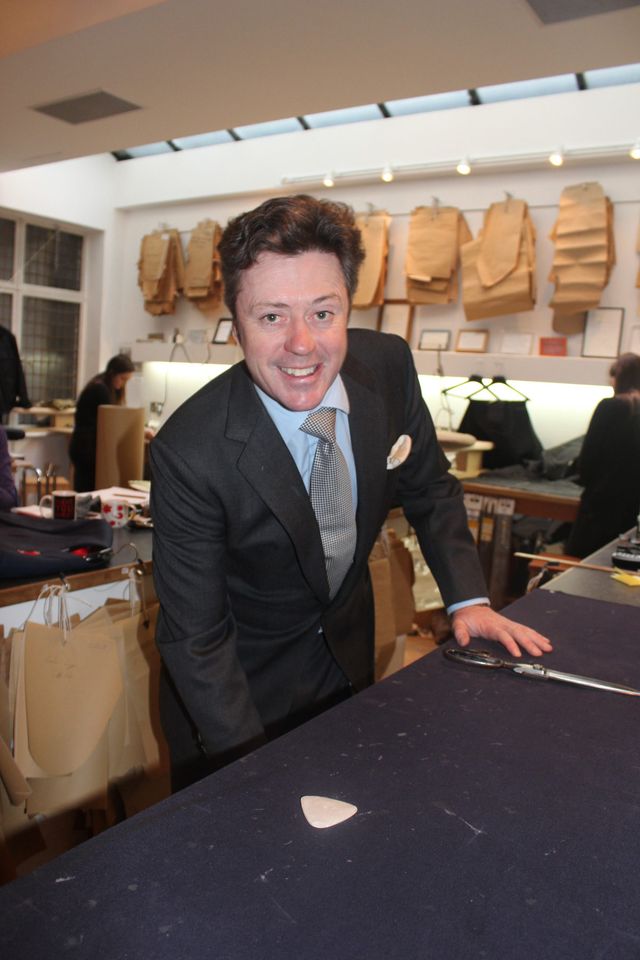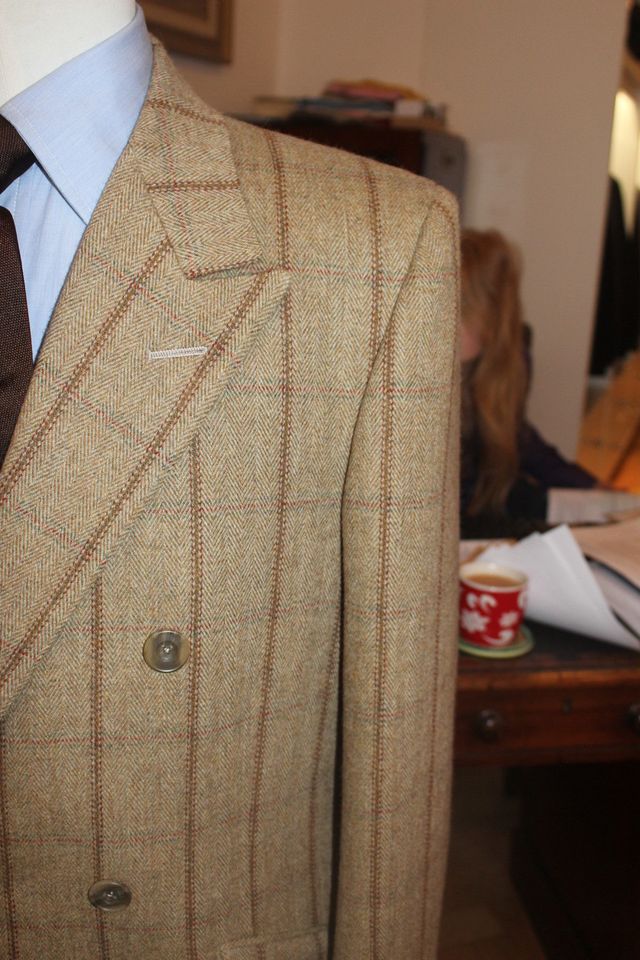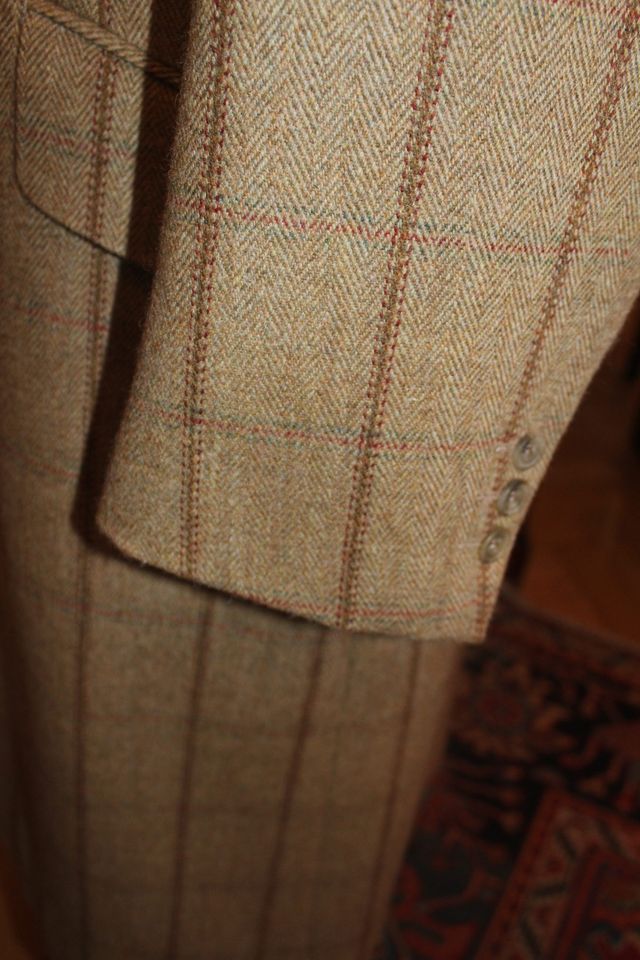
Richard Anderson is shown in his workroom.
When I was in London recently, I visited tailor Richard Anderson. Richard began his career at Huntsman, one of the most prestigious tailors on Savile Row. When the original owners sold the company, the new owners changed the standards and began cutting corners, Richard said, so he and two other employees left Huntsman in 2001 to establish Richard Anderson Ltd.
Richard, shown in his workroom, is very personable. I always enjoy visiting with him, and I always learn something new.
Richard is a cutter: He measures the customer and drafts the pattern. He uses the rock-of-eye method (not a couture term), meaning that he looks at the customer’s figure and posture, then takes that into consideration when he makes the pattern. Once the pattern is made, it’s given to the striker who chalks it out on the cloth. Then it goes to one of the tailors.
ONE TAILOR’S METHOD FOR MATCHING PLAIDS
During my visit, we discussed his method for matching plaids. He begins at a garment’s center back, because the plaids must match the collar. Then he moves to the front. The plaids don’t match on the shoulders because the back shoulder seam is about 1/2 inch longer than the front. The vertical plaid placement on the sleeve is determined by its relationship to the plaid pattern on the front; it may not be in the center of the plaid pattern at the top of the sleeve.
Notice the Oyster (metro) card he’s using as a separator to avoid catching the underlayer of the pocket.
I was particularly fascinated with the matching of the plaids on the sleeves, since they match on the front and back seams.
Richard showed me a jacket that had had the first fitting, known as “the baste.”
The plaids don’t match at the armscye, and the pitch is wrong on the sleeve.
The sleeve front should just touch the wrist lightly and not stand away from the wrist.
This could be corrected easily because the sleeve has been cut with a 4-inch hem, and the vertical seams are 2-1/2 inches wide at the wrist and about 1 inch wide at the top.
After the baste, the jacket is ripped apart. In couture, this is called, “mis à plat.” It is one of the differences between couture and made-to-measure construction. Depending on corrections, the jacket will be basted or machine-stitched for the next fitting.
All bastings stitches are removed after the baste.
For more information about Richard, visit the website RichardAndersonLtd.com or read his book Bespoke: Savile Row Ripped and Smoothed (Simon & Schuster UK, 2009).

























































I made a flared 4 gore skirt out of a black and white window pane fabric. I cut the garment out, lined up the vertical and horizontal lines, pinning where I thought appropriate (about every two inches. Even though I was careful in cutting the fabric the edges didn't line up precisely. I hand basted the center and side seams, then sewed and evened up the seams and top and bottom seams where necessary. Turned out perfect.
Claire, what is wrong with the pitch on the sleeve?
I am sorry to say that this is a very uninformative article. Just saying that the tailor matches the plaids at CB, then moves on to the back and sleeves doesn't convey any real "method." It would be very helpful if we could actually see the fabric on the table with the plaids lined up to match, especially the sleeves and fronts. I can usually match CB to collar, and backs and fronts so that that the plaids match at the shoulders (assuming the shoulder lengths are the same), but sleeves are always a crap shoot for me, even when I think I've matched the notches on the pattern front and the sleeve. So just blithely stating that that the vertical plaid pattern of the sleeve "may not be in the center of the plaid pattern at the top of the sleeve" is not much help.
What is wrong with the pitch on the sleeve? The plaid looks perfect on the sleeve from the front in the picture. I'd love for this article to have shown the layout of pattern pieces on the fabric. I know there's an old article (or 2) on Threads that explains how to lay pattern pieces out to match plaid fabric, but what is the use of this article? There are a couple of interesting photos here but no explanation at all. Did some of the article get cut off by accident? Because otherwise this makes absolutely no sense at all!
I am sorry that others thought the article was useless for not containing the precise information on how the tailors actually do match the plaids, but it was, after all, a visit with a tailor, not a lesson from a tailor. If every plaid was the same and every garment the same, then perhaps a definite method for matching would make sense.
I was always taught that one uses the armscye notches as the horizontal match points so that mainlines of a plaid will match across the body of the jacket and the lower sleeves, and when matching the plaid, one folds the cut piece on the seamline and holds it to the next piece's seamline, then pins or thread bastes the pieces at the seamline, not the cut edges.
Forgive me, Claire, if I have revealed any tailor's secrets.
I enjoyed the information presented, especially that when the new owners started cutting corners, several employees left and started their own business!!!!
Hello folks! The best way to match the plaid on a sleeve is to baste a muslin sleeves on to the jacket on both sides, draw in the plaid on both sleeves, remove the muslin and place it on the fabric to cut out the sleeves. A sure fire way to get it right without any guess work.
This is the way I teach my students to do it at Le Grand Chic Italia School of Fashion.
thanks
Maria